Seagate and Western Digital 1TB Drives: Improved and Green
by Dave Robinet on November 26, 2007 7:00 AM EST- Posted in
- Storage
WinRAR
We updated our WinRAR test methodology. We are now using a larger and more comprehensive directory structure (3 gigabytes, 302 files and 22 folders), and are using the "store" mode to eliminate the CPU as being a bottleneck in our testing. We repeat each test three times to ensure consistency. Our first WinRAR test takes our sample directory from the source WD Raptor drive and puts it in an archive on the test device. This is a good representation of a practical "write" test of the test device. We then take the newly created archive, and uncompress it on the same drive. The test therefore becomes a combination of read, write, and seek performance.
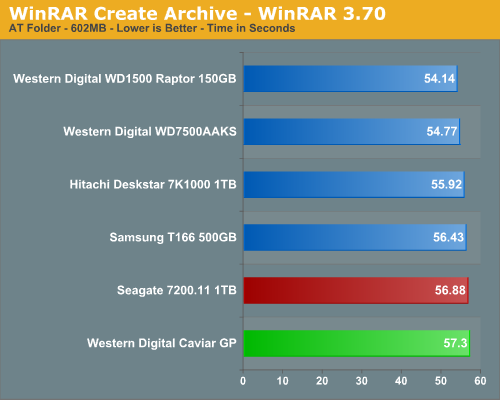
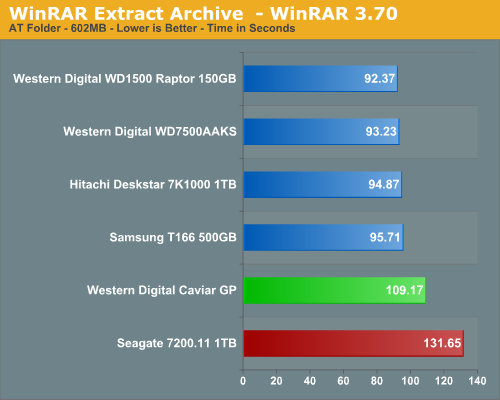
This is a very interesting result. As expected, the Samsung T166 turns in strong results compared to both the Western Digital and Seagate devices, but the real story is how poorly the Seagate 7200.11 performs in the second test. This is a real concern, as the pattern has been clear and consistent when it comes to tests involving both read and write operations. The Seagate 7200.11 clearly has a serious handicap in this regard. The Samsung T166 showed itself in previous tests to be an above-average performer, but even the Western Digital Caviar bests the Seagate by nearly 20%.
Nero Recode
Our Nero Recode test takes our Office Space DVD folder and shrinks it down to fit onto a single 4.5GB DVD. This test is highly dependent on the CPU, however, and given our newer test bed, previous results aren't directly comparable with these benchmarks.
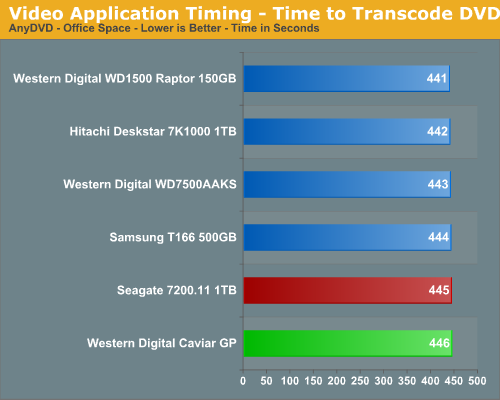
Given earlier results, the fact that the drives are separated by only 5 seconds from top to bottom means that this test is more about stressing system components (i.e. the CPU) than working out the storage medium, although a fast hard drive is still valuable.
Company of Heroes
Company of Heroes: Opposing Fronts is the latest installment in Relic's wildly popular WWII real time strategy series. For our test, we load the first campaign level (Wolfheze) and measure the time it takes to display the "press any key" message. To ensure test consistency, we are using the base installation of Opposing Fronts without keeping current with Relic's frequent patching.
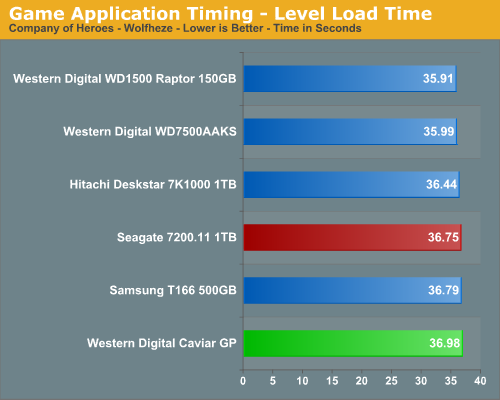
Here we see a narrowing of the performance results, though the drives continue to show results consistent with our earlier benchmarks. The T166 edges the Seagate drive very slightly, while the Western Digital Caviar GP trails the pack.
Supreme Commander
Supreme Commander is the second of our gaming benchmarks for this article. For this test, we measure the time it takes to load the first Campaign level, starting the timer when we click the launch icon and ending when the commander is visible and stationary on the ground.
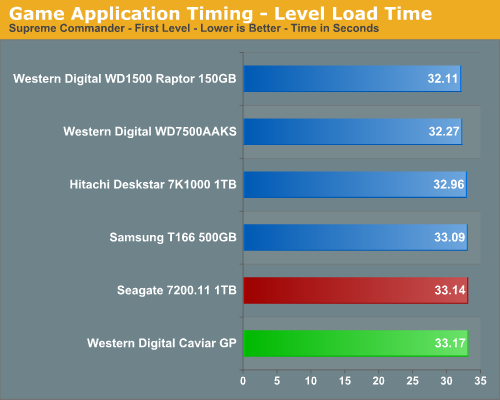
Our benchmark shows that there is very little load time differential between the fastest and slowest hard drives tested. Games such as this remain a difficult task for conventional hard drives, as they rely to such a large degree on seek times. The results, however, continue to rank the drives as before.










31 Comments
View All Comments
retrospooty - Monday, November 26, 2007 - link
I for one found the article helpful. It isn't about showing performance and choosing a winner based on speed, it is about showing all aspects of each and letting the buyer decide. Some people might want pure speed, and some might want a low power, quieter option.I think logic is lost on some people.
gmyx - Monday, November 26, 2007 - link
While 4w may not seem like much to a power user, it is a big deal to someone who is building a low power system such as a VIA based system. It's obviously not going to be used for playing games but can certainly work as a file server / internet proxy. When you can get a power supply with a total output of 60w (pico 60w power supply) every watt saved brings your total lower. A lower total mean less cost for your file server / internet proxy.Lonyo - Tuesday, November 27, 2007 - link
I would imagine it would also be nice for a low power home file server.1 of these 1TB drives would use probably <1/3rd of the power of 2x500GB drives, or ~1/2 the power of another 1TB drive.
If you have say a RAID-5 array with 5 or 6 of these drives, you're looking at a decent reduction in power which is always nice for a 24/7 machine.
Googer - Monday, November 26, 2007 - link
Those who have wanted to use low power hard drives on a desktop motherboard have always had the option of using 2.5" laptop drives.Dave Robinet - Monday, November 26, 2007 - link
Well put, Jarred.The Hitachi was reviewed some time ago, now, and (as you mention) its results are included in the charts. It gets mention in the conclusion as being the preferred option over the Seagate, as well.
The Green drive does have a place as a quiet drive (the quietest of the 1TB drives tested), and it comes at a low price point. That's considerable - particularly for HTPC users, who may not appreciate the Hitachi's noise.
For performance-oriented applications, though, it's a tough sell.
DigitalFreak - Monday, November 26, 2007 - link
Me thinks that this whole "green" thing from WD is because they were having issues producing a performance drive. Maybe the lower power consumption would make sense in a laptop drive, but I'd much rather have performance on the desktop.Seagate's ATA drives have always been so-so performers, so I'm not surprised with the outcome. However, they 5 year warranty more than makes up for it in a home server environment.
jojo4u - Monday, November 26, 2007 - link
Other drives are performing well. It's nice to have the choice. And there are uses for low-power high-capacity drives.jojo4u - Monday, November 26, 2007 - link
See page 2 and page 3 http://www.storagereview.com/1000.sr?page=0%2C2">http://www.storagereview.com/1000.sr?page=0%2C2Your low-level results also back this up.
DigitalFreak - Monday, November 26, 2007 - link
There was a discussion on their forums about how it would be prohibitively expensive to produce a drive that could vary it's spindle speed due to the extra stress on the mechanism.Interlink - Tuesday, November 27, 2007 - link
Anybody with a mic e.g. in his headset and a PC with microphon input is able to measure the fixed spindle speed of a WD10EACS: [url=http://forums.storagereview.net/index.php?showtopi...">http://forums.storagereview.net/index.p...c=26021&...]5400 rpm[/url].